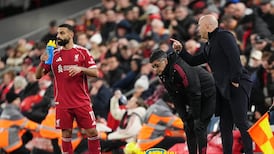Damien Duff made a salient point ahead of the League of Ireland’s return tonight. It’s always been a numbers game.
The legendary Irish winger turned Shelbourne manager spelled out the vast financial advantages Shamrock Rovers, Derry City, and arguably Dundalk and St Patrick’s Athletic, hold over perennial also-rans.
“A player with a lot experience in the league that has a bit of quality costs €1,200 a week,” said Duff, providing a rare glimpse of the bottom line. “I might be able to get one or two or three [players on that weekly wage] but a lot of the teams above us can keep forking that out, and I can’t.”
---
READ MORE
Fixtures
Friday
Shelbourne v Drogheda United
St Patrick’s Athletic v Derry City
Dundalk v UCD
Cork City v Bohemians
Saturday
Sligo Rovers v Shamrock Rovers
---
Salary of €62,400
That’s an annual salary of €62,400 to headline the greatest league in the world. With a total prize fund of €430,000, Rovers will bank just €125,000 if they emulate Jim McLaughlin’s four-in-a-row side from the 1980s.
Derry under Ruaidhrí Higgins and billionaire chairman Phillip O’Doherty are unashamedly focused on denying Stephen Bradley’s men from revisiting this historical milestone.
Last place takes €22,000 with them into the first division. UCD are odds on to drop down as increased investment in club academies lures students away from the Belfield campus.
“The most appealing aspect of coming to UCD is access to the first team,” said manager Andy Myler.
“But the league seems to be only going one way: full-time professional teams. That is not a bad thing, but we have to work out where we fit in that structure. There is a bit of thinking that has to go into it. We have facilities that are Premier League level, never mind League of Ireland level. People can stay on campus, once they are students, so if we really squeeze it over the next number of years, there could be a working model whereby we have a group of full-time professionals in college.
“The rugby managed to do it in terms of lads who are in with Leinster keeping college going on the side. I think we have to look at a model like that.”
Cork City return to the top flight under new ownership as Dermot Usher provides manager Colin Healy with enough funds to build a competitive squad that now includes Swedish trio Albin Winbo, Kevin Čustović and Daniel Krezic.
But it remains a numbers game, and the numbers do not add up until safe passage into the Europa Conference League group stages is secured, even with post-pandemic fans returning in droves to stadiums that remain unfit for purpose.
“We’re trying to get investment,” said League of Ireland director Mark Scanlon. “And we are putting the final touches to our facilities plan, which covers not just the league but grassroots and the national training centre. Hopefully we’ll have significant improvements but unfortunately these things take time.”
Translation: if the government increases the betting levy, which has ploughed €1.5 billion into horse and greyhound racing since 2001, from 2 to 3 per cent then Irish soccer can launch serious plans to create a football industry on the island.
“I don’t want to give any commitment,” said Minister of State for Sport Thomas Byrne. “We’ve gone through a whole load of gambling regulations in the last few months so I’m not certain I want to go there yet. But it’s a matter for the Minister for Finance.”
Meanwhile, Tolka Park and Dalymount remain decrepit old grounds badly in need of Government funding, which may or may not materialise before this decade ends.
Shels would awake from their slumber if Southampton owners Soccer Republic or an unknown American billionaire take a stake in a club where Duff is forced to invest in “loads of kids” who “don’t answer back”.
Speaking of youngsters, St Patrick’s Athletic should in theory pack the rafters at Richmond Park for every game that involves their 17-year-olds, Sam Curtis and Adam Murphy.
“You know by the way [Murphy] passes the ball to you that he is going to be a good player,” veteran Pats striker Eoin Doyle told LOI Central.
A truly gifted pair, Curtis and Murphy could be away to England in the summer transfer window, if not sooner. The same goes for Rovers midfielder Justin Ferizaj, who turned 18 in January, with a recent trial at Spurs set to accelerate his departure.
“That’s the nature of the game,” said Stephen McPhail, the Rovers sporting director since 2016, who once upon a time was primed for a career running the Leeds United and Republic of Ireland midfields.
“No one remembers that, including me!” laughed McPhail (43) at this week’s league launch in City Hall. “There are everyday life lessons I took from Leeds, when it was one of the best academies in English football, that I still use to this day as a father. The Rovers academy focuses on making our young players better people as much as they are equipped to be good professionals by the time they graduate.”
Whatever happens next, Brexit has been kind to the league by forcing Irish talent to stay home until they turn 18. This allowed Jamie Mullins to develop at Bohemians, until Brighton came in, and Aidomo Emakhu at Rovers, until Millwall signed him.
At least Bohs sorted their management structure with Pat Fenlon’s return as director of football, having led the club to successive league titles in 2008 and 2009, and manager Declan Devine endeavouring to steady a ship that continues to lose more quality deckhands than it can unearth.
Like Andy Lyons last season, the consistently excellent Liam Burt has moved across town to join a Rovers squad constructed to retain the league and make a lasting impression in Europe. This proved impossible in 2022, mainly because of Derry City’s late effort to snatch the title. Two draws and four defeats was a poor return from trips to Belgium, Sweden and Norway but domestic affairs took precedence.
The arrival of Burt, Estonian international Markus Poom and teenage striker Johnny Kenny, on loan from Celtic, strengthens Rovers’ hand in key areas after Chris McCann joined Burton Albion.
Derry have also been busy, taking Adam O’Reilly off St Pat’s and signing Ireland under-21 striker Colm Whelan from UCD.
If Whelan catches fire, Higgins’ side could conceivably join Rovers in the ECL group stages, which guarantees at least €3.3 million in prize money and €500,00 for every win thereafter. That’s how the big fish in this small pond can pay players €1,200 a week.
Basic advancements
The FAI, through Scanlon’s steady hand, are making incremental structural changes to professionalise a league previously branded the “difficult child of the organisation” by former chief executive John Delaney.
Basic advancements, that should have happened a long time ago, like a minimum wage of €22,360 for full-time players, which amounts to €430 a week, are now in place. There is also a guarantee of 48-week contracts, which allows part-time players to start on €6,760 or €130 a week.
For the youngsters, this drops down to €280 a week for full-time under-17 players and €90 for part-time hopefuls.
Again, it is a welcome start in Irish football’s slow march towards respectability.
LOI TV also strives to make a splash in the streaming market but €120 for the season pass or €7 per match is pricy when compared to the NBA league pass, to see the best basketballers on the planet, charging €100 or €3.40 per game.
At least the FAI aim to post extended highlights on YouTube by 11pm every Friday night. Because eyes, views and clicks matter in 2023; it being a numbers game.














